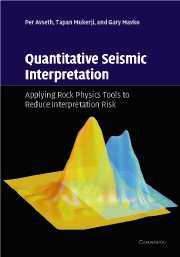Book contents
- Frontmatter
- Contents
- Preface
- 1 Introduction to rock physics
- 2 Rock physics interpretation of texture, lithology and compaction
- 3 Statistical rock physics: Combining rock physics, information theory, and statistics to reduce uncertainty
- 4 Common techniques for quantitative seismic interpretation
- 5 Case studies: Lithology and pore-fluid prediction from seismic data
- 6 Workflows and guidelines
- 7 Hands-on
- References
- Index
- Plate section
3 - Statistical rock physics: Combining rock physics, information theory, and statistics to reduce uncertainty
Published online by Cambridge University Press: 27 January 2010
- Frontmatter
- Contents
- Preface
- 1 Introduction to rock physics
- 2 Rock physics interpretation of texture, lithology and compaction
- 3 Statistical rock physics: Combining rock physics, information theory, and statistics to reduce uncertainty
- 4 Common techniques for quantitative seismic interpretation
- 5 Case studies: Lithology and pore-fluid prediction from seismic data
- 6 Workflows and guidelines
- 7 Hands-on
- References
- Index
- Plate section
Summary
Any physical theory is a kind of guesswork. There are good guesses and bad guesses. The language of probability allows us to speak quantitatively about some situation which may be highly variable, but which does have some consistent average behavior.
Our most precise description of nature must be in terms of probabilities.
Richard Phillips FeynmanIntroduction
This chapter introduces the concepts of statistical rock physics for seismic reservoir characterization. We will see how we can quantify uncertainties in reservoir exploration and management by combining rock physics models with statistical pattern recognition techniques to interpret seismic attributes. Plate 3.1 shows an example of results from a statistical rock physics study. Seismic impedances from near and far-offset inversions were interpreted using well logs and rock physics to estimate the probabilities of oil sands. The figure shows the iso-probability surface for 75% probability of oil-sand occurrence. Statistical rock physics is also useful for identifying additional information that may help to reduce the interpretation uncertainties. Seismic imaging brings indirect, but nevertheless spatially extensive information about reservoir properties that are not available from well data alone. Rock physics allows us to establish the links between seismic response and reservoir properties, and to extend the available data to generate training data for the classification system. Classification and estimation methods based on computational statistical techniques such as nonparametric Bayesian classification, bootstrap, and neural networks help to quantitatively measure the interpretation uncertainty and the misclassification risk at each spatial location.
Information
- Type
- Chapter
- Information
- Quantitative Seismic InterpretationApplying Rock Physics Tools to Reduce Interpretation Risk, pp. 111 - 167Publisher: Cambridge University PressPrint publication year: 2005
